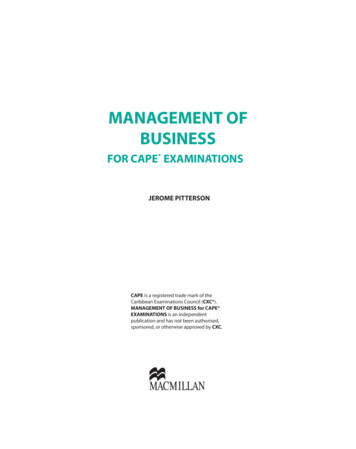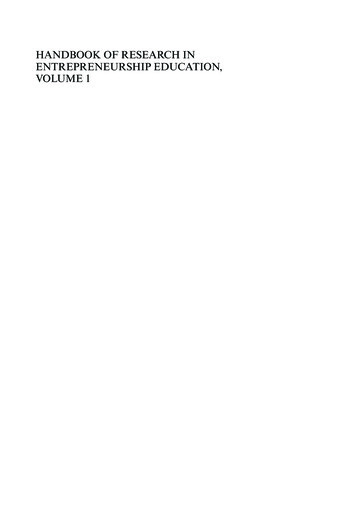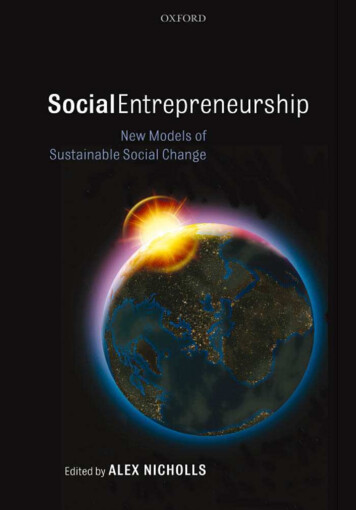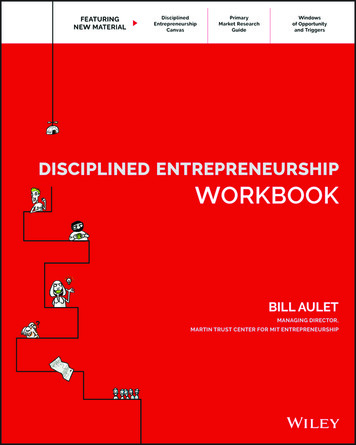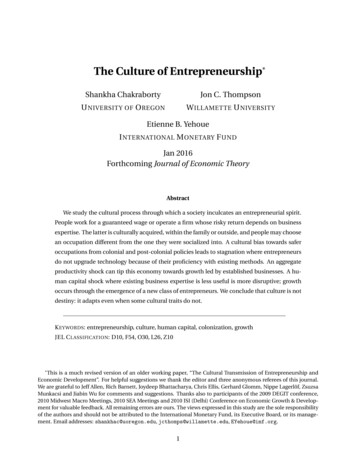
Transcription
The Culture of Entrepreneurship*Shankha ChakrabortyJon C. ThompsonU NIVERSITY OF O REGONW ILLAMETTE U NIVERSITYEtienne B. YehoueI NTERNATIONAL M ONETARY F UNDJan 2016Forthcoming Journal of Economic TheoryAbstractWe study the cultural process through which a society inculcates an entrepreneurial spirit.People work for a guaranteed wage or operate a firm whose risky return depends on businessexpertise. The latter is culturally acquired, within the family or outside, and people may choosean occupation different from the one they were socialized into. A cultural bias towards saferoccupations from colonial and post-colonial policies leads to stagnation where entrepreneursdo not upgrade technology because of their proficiency with existing methods. An aggregateproductivity shock can tip this economy towards growth led by established businesses. A human capital shock where existing business expertise is less useful is more disruptive; growthoccurs through the emergence of a new class of entrepreneurs. We conclude that culture is notdestiny: it adapts even when some cultural traits do not.K EYWORDS: entrepreneurship, culture, human capital, colonization, growthJEL C LASSIFICATION: D10, F54, O30, L26, Z10* This is a much revised version of an older working paper, “The Cultural Transmission of Entrepreneurship andEconomic Development”. For helpful suggestions we thank the editor and three anonymous referees of this journal.We are grateful to Jeff Allen, Rich Barnett, Joydeep Bhattacharya, Chris Ellis, Gerhard Glomm, Nippe Lagerlöf, ZsuzsaMunkacsi and Jiabin Wu for comments and suggestions. Thanks also to participants of the 2009 DEGIT conference,2010 Midwest Macro Meetings, 2010 SEA Meetings and 2010 ISI (Delhi) Conference on Economic Growth & Development for valuable feedback. All remaining errors are ours. The views expressed in this study are the sole responsibilityof the authors and should not be attributed to the International Monetary Fund, its Executive Board, or its management. Email addresses: shankhac@uoregon.edu, jcthomps@willamette.edu, EYehoue@imf.org.1
1 IntroductionThis paper connects culture to entrepreneurship and economic growth using a model of intergenerational households. Our goal is to identify conditions under which culture matters fordevelopment and the same society, freed from its moorings, enjoys rapid growth.In a model of occupational choice people are either workers or entrepreneurs. The formerwork for a guaranteed wage, the latter engage in risky business activities. People differ in skills forand subjective biases over the two occupations. These are acquired through upbringing, socialization and occupational experience. Because of bounded rationality, paternalistic parents prefertheir offspring to choose occupations they value. For example, a wage-worker parent who perceives entrepreneurship as too risky and values safe employment prefers that his children choosean occupation in a similar risk-class. Similarly, an entrepreneur parent, being adept at running abusiness, perceives it to be rewarding and tries to pass on his expertise. When within-family cultural indoctrination fails, a child acquires the human capital of a randomly chosen member of theactive population. Either way, children’s human capital is determined by adulthood at which pointthey choose occupations.Entrepreneurs either use the prevailing technology or upgrade to a more productive vintageat the cost of higher risk. A cultural bias towards safe production eventually leads to stagnationwhere entrepreneurs, because of their considerable proficiency, stay with existing methods of production. This low (zero) growth equilibrium is analogous to colonial and post-colonial regimeswhere safe employment was highly valued, the pursuit of profits frowned upon and businesseswere insular. Escaping stagnation is possible from an exogenous, significant increase to overallproductivity or to the human capital specificity of technologies. In the first, growth occurs throughinnovation by existing entrepreneurial lines that retain their dominant position. In the second,newer entrepreneurial lines emerge that innovate precisely because they lack expertise in prevailing methods. In neither case does culture hold back economic progress.The notion that culture could matter for economic growth is not new. It goes back at leastto Weber’s (1930) thesis that cultural change, the Calvinist Reformation in particular, was vital tothe development of capitalism and its institutions. While some have extended that view to cultural attributes such as openness to new ideas and a scientific temperament (Landes, 1998), others have seen virtue in the West’s individualism (Lal, 1999a, and references therein). Despite thisabiding historical interest and an emerging one in empirical development economics (for instanceTabellini, 2010, Gorodnichenko and Roland, 2013), culture has received little formal treatment inmodern growth theory. In large measure this reflects the widespread notion that development islimited only by opportunities and technologies: if incentives are strong enough, culture wouldchange to accommodate economic interests.1 While our work embraces this conclusion – culture1Even as Weber saw virtue in the Protestant ethic, he thought Confucian values would hinder East Asia’s prospects2
does not limit growth as long as the economy is productive or technological change disruptiveenough2 – we also show that culture matters for the income level.“Culture” has two related interpretations in this paper, one static, the other dynamic. The staticone is an anti-capitalism or anti-innovation bias, a “collective programming of the mind which distinguishes the members of one group (workers) from those of another” (Hofstede, 1991, p. 5). Thispartly shapes the dynamics of culture, the willingness to intergenerationally transfer “via teachingand imitation, . . . knowledge, values, and other factors that influence behavior” (Boyd and Richerson, 1985, p. 2). Differently from Becker (1993), the socialization process is not seamless sincepurposeful parental involvement can fail, opening the door for social influence. Differently fromBisin and Verdier (2000, 2001) and Hauk and Saez-Marti (2002), human capital, not preference,is transmitted culturally. Our assumption of occupation-specific cultural bias is related to Corneoand Jeanne’s (2010) work on the social esteem attached to certain occupations. More generally thispaper is related to preference- and evolution-based explanations of long-term change, includingBecker and Mulligan (1997), Doepke and Zilibotti (2008), Galor and Moav (2002) and, more recently, Galor and Michalopoulos (2012) and Wu (2014). What distinguishes our paper from theliterature are its focus on technology-specific human capital and the overarching theme: “whendoes culture not matter for growth?” That culture need not be decisive marks a novel contributionand connects the theory to historical and recent episodes where an economy once held back bycultural inertia transitions to modern economic growth.A benchmark model of occupational choice and cultural transmission is developed in the nextsection under the assumption that entrepreneurs are locked into a particular technology. Technological upgrading is studied in section 3. We show that the constant-technology model is a specialcase of this general structure and characterize the dynamic equilibria. Section 4 discusses the implications of productivity shocks. Section 5 concludes.2 The Baseline ModelChildhood and adulthood are the two stages of life in an overlapping generations economy. Inany period t 1, 2, . . . , a set H of agents of measure one is economically active in either of twooccupational classes that differ in their risk. We model these as two specific occupations, wageand the caste system India’s (Weber, 1951, 1958). This simple and deterministic view of culture is inadequate to thetask of explaining the subsequent growth takeoffs in Asia. Also influential has been an earlier debate in the profession between those who proposed culture-based non-rationality as an explanation for agricultural backwardness intraditional societies and those who took the “poor but efficient” view of peasant agriculture, a debate that Schultz’Transforming Traditional Agriculture (1963) resolved convincingly in favor of the latter (Ruttan, 1988).2The growth rate does not depend on the share of the population consisting of entrepreneurs. It is this that ensuresculture does not affect growth, unlike in Doepke and Zilibotti (2013) and Klasing (2014), as long as the economy enjoystechnological progress. It does affect, however, the choice to upgrade technology. On how culture affects innovationand technology adoption and evidence of intergenerational transmission see Spolaore and Wacziarg (2013).3
work and entrepreneurship, that are complementary in production. Labor income w t is risklesswhile entrepreneurial income πt is risky.The tight categorization of the two occupations is for convenience; it is also informed by theprotectionist and strongly pro-labor development policies pursued around poorer countries in thelast century. The essential assumption is that one of the occupations is riskier. They do not have toproduce goods or services that are complementary in production; substitutable goods that enjoythe same rate of productivity growth would deliver qualitatively similar results. Complementarityis assumed to establish a balanced growth path later: when growth occurs because of innovationby entrepreneurs, returns to the two occupations have to grow in tandem for household decisionsto be stationary.Each agent is endowed with a unit time and gives birth to one offspring during this period,dying at the end. An offspring born in t does not become economically active until t 1.2.1 Preferences and Cultural BiasThe expected lifetime utility of an economically active individual at time t depends on his lifetime income, y t {w t , πt }, the perceived welfare of his offspring, Vt , and socialization cost ψ(τt )U t u(y t ) Vt ψ(τt ).Agents are risk averse over their lifetime income (consumption): u(y t ) E t (ln y t ).Vt and ψt are fully specified later. For now we note that they embody paternalistic behaviorand cultural biases. In particular, children are not born with innate skills in the two occupations ora preference about which occupation is “better”. The first develops through cultural transmissionat home (vertical transmission) or socialization outside (oblique transmission), the latter is theproduct of work experience and cultural milieu.Parents are paternalistic in that they believe they know better which occupation would better suit their children (Bisin and Verdier, 2000). In this they are not irrational, only boundedlyrational. Specifically V depends on a parent’s projection of his child’s expected utility based onthe parent’s own human capital. This projection is endogenous, it depends on intergenerationalhuman capital accumulation and the equilibrium wage rate. Moreover, over their working livesparents acquire a subjective bias towards the occupation they value and have worked in; they dislike the prospect of their children going into an occupation that is in a different risk-class. Forexample, non-entrepreneurial parents prefer their children to be formally educated/trained for awell-compensated profession such as medicine, engineering, education or public service. Parentsof this type dislike having their children abandon these (arguably) low-risk professions in favor of4
business which the parent, because he has little expertise about, perceives to be too risky.3Not all parent-to-biological-child vertical transmission is successful since children also socialize and absorb ideas outside of home. Higher parental effort τ (0, 1) towards cultural educationraises the likelihood of the offspring having similar expertise as the parent. But due to socializationoutside, such education may fail and the offspring picks up expertise from a randomly matched(cultural) parent who may well be in an occupation different from his biological parent’s. We referto this process of vertical and oblique transmission as cultural indoctrination.2.2 Occupation and ProductionEntrepreneurs engage in production through imperfectly understood technologies while workers supply labor on a competitive market.4 People differ in how they subjectively value the two occupations and in their human capital. We treat this human capital as one dimensional – businessexpertise – that in the model takes the form of subjective beliefs about the riskiness of productiontechnologies.At the beginning of each period, an active agent must decide whether to become an entrepreneuror work for entrepreneurs at the market wage. Human capital in entrepreneurship and the broadermacroeconomic environment determine this choice.5 We assume no unemployment or withdrawal from the labor force. Lifetime income y is either profit income π or wage income w. Inother words, individuals indivisibly supply their labor to wage-work or in managing their business. Labor income is certain and the wage rate is taken as given by agents: E t (ln w t ) ln w t .Entrepreneurs, however, face uncertainty and their expected utility from profits depends on theirbusiness expertise (see below).Let E t denote the subset of agents who become entrepreneurs at t and H \E t the subset whowork for a wage. Product and input markets are perfectly competitive. All workers are hired byentrepreneurs at the market wage rate w t and all entrepreneurs produce the same homogeneous3In some ways, this interplay of personal experience and transmitted information parallels the intergenerationallearning mechanism identified in Piketty (1995). In both cases, learned history influences decisions. The differenceis that in our model parents decide how much effort to place on transmitting their information and may saddle theirchildren with poor information sets simply because they lack expertise in alternative occupations.4The alternative occupation can also be low-scale self-employment with lower returns. In other words, here entrepreneurship is not synonymous with self-employment. Rather, an entrepreneur is someone willing to embrace bigchange and innovate. This distinction is useful to keep in mind as a lot of empirical work proxies entrepreneurshipwith self-employment which is widespread in developing countries, often exceeding rates in industrialized countries.5Implicitly the labor productivity of all individuals is being normalized to unity. It is easy to introduce heterogenous human capital specific to wage work and allow wage-working parents to transfer their skills to their offspringand build on them. As long as there is no market imperfection preventing the efficient level of such within-family investment and human capital accumulation is subject to diminishing returns, all wage-working families will eventuallyconverge to the same skill level. What matters in that setup, as here, is an individual’s comparative advantage in thetwo occupations; see Chakraborty et al. (2015).5
good {Yk }k E using a CRS technology.6 Aggregate output is simplyZYt EtY tk d k.The price of each good is normalized to one. Entrepreneur (capitalist) k uses two inputs, labor L kthired in the competitive market and his own input z̃ tk :³ 1 β ³ βL kt , β (0, 1).Y tk z̃ tk(1)The input, z̃ k , is essentially entrepreneurial human capital that embodies k’s expertise on how torun the business. For convenience we will call it business capital, an intangible asset to the firm.This input is ex ante uncertain. It depends on the technology, the entrepreneur’s skill in using ofit and business decision φ taken before workers are hired and goods produced. The capital thusproduced is an inalienable part of entrepreneur k’s business venture, non-transferable to otherbusinesses.7We solve for the decision problem backwards. Given z tk , profit maximization leads to the labordemandÃβ!1 βz tk wtL kt(2)with more productive entrepreneurs – those with higher business capital z – hiring more. Usingthis in equation (1), the entrepreneur’s profit flow (prior to realizing the uncertainty) is the randomvariableπ̃ktµ ¶β/(1 β)βz̃ tk κt z̃ tk (1 β)wt(3)which is increasing in business capital chosen prior to going into production.Denote the technology at the entrepreneur’s disposal by some arbitrary index n 0. Entrepreneurk takes a decision φkt that determines his business capital according to a stochastic productionfunction similar to Jovanovic and Nyarko (1996):¡kz̃ nt an e q nt φknt 2, a 1(4)whereq nt θn νnt(5)is a random target that fluctuates around a technology-specific parameter θn and νnt is an iidshock drawn from a normal distribution with mean zero and variance σ2ν . The same technology is6While k represents a particular entrepreneur, b is used later to tag variables for the entire set E t .In section 3 productivity growth will arise from improving quality of business capital. In light of Uzawa (1961), theCobb-Douglas technology allows us to rewrite it as labor-augmenting growth in steady state.76
used by all entrepreneurs and for all t 1. Later we allow them to choose between two technologies that differ in risk and return: higher vintages (n) are inherently more productive since a 1but entrepreneurs may be less informed about them.The entrepreneur knows a and the distribution of νnt . What he does not know is the meantarget output θn , but has some belief (prior) about it. These priors are centered on the true parameter values: Bayesian updating ensures that they remain unbiased as long as initial priors in thepopulation were so. One way to interpret φ is as effort devoted towards fine-tuning some machinery that yields a stochastic output, based partly on how effectively it is employed in production.Alternatively and closer to the spirit of the model, think of the entrepreneur as entering a market or innovating a product for which he needs to determine the optimal scale of operation q ntwithout having full information about market conditions. The quadratic loss function embeddedin (4) says that he can lose out from both over- and under-supply of business capital, a reducedform specification of having to sell below cost in case he overestimates market demand or forgoingprofits if he underestimates.kLet E tk (θn ) be k’s conditional expectation and x nt Vtk (θn ) conditional variance of θn . Thecumulative distribution of x nt in the population is denoted by G t (x nt ), with G 1 (x n1 ) given in theinitial period and G t for t 1 determined via cultural indoctrination and occupational choice.Priors about θn in period 1 are assumed to be, and subsequent priors turn out to be, drawn from anormal distribution.kProposition 1. For entrepreneur k with the prior x nt(i) Expected utility from profit income is maximized atφknt E tk (θn ) .(6)(ii) This yields expected business capital ofkz̄ nt³k E t z̃ nt qan¡ k 1 2 x nt σ2ν(7)and(iii) Maximized expected utility from profit income ofkk) n ln a ln κt x nt σ2νE (ln π̃kt x nt¡ β/(1 β)where κt (1 β) β/w t.Proof. See Appendix A.7(8)
Business capital is higher the closer is the entrepreneur’s decision φknt to the target output levelk– is an expertise. Entrepreneursq nt . Equations (7) and (8) show that the entrepreneur’s belief – x ntk– expect to earn a higher return from entrepreneurship.with more informed beliefs – smaller x ntIn observing q nt during his lifetime, the agent learns about the technology and updates his beliefabout θn . He then tries to impart this knowledge to his cultural offspring who, in turn, will be ableto make a more informed decision φkn,t 1 should he become an entrepreneur. This means if entrepreneurial human capital is transmitted via cultural transmission, business expertise specific toan entrepreneurial line does not disappear.8 The learning process is bounded for a given technology (see below): sticking with the same n along an entrepreneurial line allows agentsq to eventuallylearn θn completely. Consequently, expected business capital converges to a n / 1 2σ2ν in thelimit.92.3 Socialization and Cultural TransmissionDenote the culturally indoctrinated fraction of wage workers in the population by m and theiractual frequency by µ. When an agent endowed with his cultural parent’s human capital choosesan occupation different from the parent’s, m 6 µ. We introduce two definitions:Definition 1. Cultural indoctrination is persistent if a cultural offspring does not choose an occupation different from that in which he has been indoctrinated.Definition 2. Cultural indoctrination is dynamically persistent if it is persistent for all agents andall t 1.We proceed to study an intertemporal equilibrium path that is dynamically persistent, that is, m t µt for all t 1. Hence the dynamics of m is identical to that of µ.A parent educates his naive biological child with the socialization effort τ, for example by selecting childhood activities, screening peer groups and, more generally, shaping the child’s views.With probability equal to parental effort, vertical transmission is successful and the child acquiresthe biological parent’s type, here human capital (Hauk and Saez-Marti, 2002). That is, the child ofan entrepreneur parent picks up the parent’s posterior belief about technologies as his own priorand a child of a wage-worker parent likewise acquires his parent’s uninformed belief regardinghow to operate businesses. If vertical transmission fails, the child remains naive and gets randomly matched with somebody else whose occupation-specific human capital he acquires. Recallthat business capital is stochastic and an inalienable part of an entrepreneur’s venture. Though it8There is no mean reversion in intergenerational ability unlike Caselli and Gennaioli’s (2013) model of dynasticfirms. Of course, neither do we have dynastic firms: what we call an entrepreneurial line is a series of entrepreneurs –some biologically related, some culturally – who are linked through their human capital.9Even an entrepreneur who learns θn precisely faces (price, demand) uncertainty via νnt .8
is not possible to acquire business expertise simply by observing a single entrepreneur’s success(which could be due to luck), naive children can absorb it from repeatedly observing enough suchsuccesses, a proxy for which is the frequency of entrepreneurs in the population 1 µ. This makesbusiness expertise partially excludable. Successful intergenerational transmission of human capital is what introduces a status quo occupational bias to the model; social influence partly alleviatesit. Let p t denote the probability that a child of a type parent will be of type where , {k, w},k denoting entrepreneurship and w wage-work. For a wage-working parent¡ wp tw w τwt 1 τt µt¡ p twk 1 τwt (1 µt )(9)(10)and for an entrepreneurial parent³ p tkk τkt 1 τkt (1 µt )³ p tkw 1 τkt µt(11)(12)where τk is the entrepreneurial parent’s effort on social education.The cost of socialization effort ψ (τ) satisfies ψ0 0, ψ00 0, ψ(0) ψ0 (0) 0 and ψ [0, 1].Let V denote the utility a type parent derives from his child being type . Parental altruism ispaternalistic in the sense that the parent uses his own payoff matrix to evaluate this utility. Hencegiven the parent’s expected returns y t , each parent of type {w, k} chooses the social educationeffort τ to maximize¡ ¡ p t V y t p t V y t ψ (τt ) .Substituting (9) (12) into the first order condition for an interior optimum ¡ d pt¡ ψ (τt ) d p t V yt V y t τtd τtd τtleads to¡ ψ τwt τw¡t k ψ τt τkth¡ i¡ V w w y tw V wk y tw (1 µt ),h³ ³ i V kk y tk V kw y tk µt .It follows thathi¡ ¡ τt τ µt ,V y t Vt y t , , {k, w}9(13)
kwith τwt / µt 0 and τt / µt 0: parents have less incentive to educate their children the morefrequent their type is in the population. Henceforth we work with the functional formψ(τ) τ2 /2for which ww Vtwk ,τwt (1 µt ) V t τkt µt Vtkk Vtkw .(14)It remains to specify how parental altruism depends on the offspring’s occupation. Lackingthe ability to accurately assess the alternative, parents project the utility of their children based onktheir own experience. An entrepreneurial parent’s human capital is his belief x ntabout the distri-bution of θn . Conversely, a wage-working parent lacks human capital specific to entrepreneurialactivities which results in a more dispersed prior of x n (see below). Based on these, we specifyparental utilities asVtw w ln w t , ¡Vtwk E t ln πkt (x n ) ln δw n ln a ln κt x n σ2ν ln δw ,¡ Vtkk E t ln πkt (x nt ) n ln a ln κt x nt σ2ν ,(15)Vtkw ln w t ln δb .The parameters δb (same for all k) and δw denote the subjective dissatisfaction that a type parentfeels when his child ends up in type occupation. These biases do not affect choice of or utilityfrom own occupation, only socialization effort.Model predictions are not sensitive to the bias parameters δw and δb but they serve two roles.They proxy for cultural attributes that are “hardwired”, those that do not directly respond to economic incentives. Even so cultural change will be possible when socialization effort changes inresponse to market forces. In other words, even though δw and δb are exogenous, their averageincidence – frequency of people with these biases – is endogenous.Second, these biases parsimoniously capture the socio-political milieu in developing countries, particularly those with a colonial past, as they embarked on development policymaking.Barring the Western Offshoots, all former colonies pursued state-led development soon after independence. This was very much a product of their colonial history. Whether through consciouspolicy choice or exposure to global trade, colonization often decimated local industries, depletednatural resources and confined local entrepreneurs to trade and commerce. The decision to pursue state-led development stemmed from the belief that market-based development would berapacious, ill suited to tackling chronic poverty (Roy, 2002).South Asia, particularly India, is a prime example of this thinking. By 1961 India’s public sector accounted for close to 58 percent of the total organized sector employment, a number that10
increased to 68 percent by 1981 before reversing in the 1990s (India Labour Market Report, 2008).Besides offering better-paid and more secure jobs than the private sector, the public sector alsobenefited from how colonization had shaped India’s educational system and middle-class aspirations. The colonial administration promoted certain kinds of education and role models to attractIndians into the administrative service. The by-product was a value system where securing government jobs was perceived as success by the educated elite. Restrictive licensing policies fromthe mid-1960s added to this: “The contempt in which merchants and markets have traditionallybeen held in Hindu society was given a new garb by Fabian socialism which appealed to the newlywesternized but traditional literary castes of India” (Lal, 1999b, p. 36).The essential contours of this story – the slant towards public sector jobs and a cultural biasaway from risky entrepreneurship – apply also to colonial Africa. The British, and to a lesser extentthe French, relied on Africans who were either traditionally-recognized leaders such as chiefs ornewly-trained technocrats who would work as middlemen. The system created a set of native administrators, public education systems and easily identifiable characteristics such as western education, Christianity and western attire that set apart the educated African. That educated Africanwas not just aiding the colonial enterprise in his capacity as a government clerk, a teacher or an administrator, he was also projecting a modern image for rest of society to value and emulate (Ekeh,1975).A high δw , particularly if one were to include the public sector into aggregate production inthe model, and low δb , are therefore natural descriptions of these two cases. It is useful to think of (x n , δb , δw ) as the “cultural endowments”, those aspects of preferences and skills that have animpact on the cultural transmission of attitudes (Hayami and Ruttan, 1985). Importantly, culturalendowments have an economic significance here since they shape perceived occupational returns.2.4 Occupational Income and ChoiceEntrepreneurship is preferred as long as it yields a higher expected utility. Entrepreneur k operating technology n in t , starts with a belief about the distribution of θn which is, as specifiedkabove, normal with variance x nt. During the course of his lifetime, the accumulated experience ofobserving q nt leads him to update this belief tokkx nt 1 F (x nt ) kσ2ν x ntkσ2ν x nt.(16)This posterior belief is then transferred, through imperfect cultural transmission, to the offspring0as his prior. Since F is increasing and concave with F (0) 0 F (0), it has a unique fixed point atx n 0. Hence the learning process along an entrepreneurial line – each generation of entrepreneurk passing on his accumulated human capital – generates a sequence of variances {x nt}t 1 that con-11
verges monotonically to zero. In this sense, the entrepreneurial line eventually achieves full proficiency if it were to stay with technology n forever.From each entrepreneur’s labor demand"wt βaggregate labor demand is L Dnt REtkz nt#1 βL knt,1/(1 β)L knt β1/(1 β) Znt /w twhere Znt REtkis aggregatez ntbusiness capital. Since each worker supplies a unit time, aggregate labor supply is L St µt , usingwhich we get the market-clearing wage rateZntwt βµt· 1 β(1 µt )z̄ nt βµt· 1
KEYWORDS: entrepreneurship, culture, human capital, colonization, growth JEL CLASSIFICATION: D10, F54, O30, L26, Z10 *This is a much revised version of an older working paper, “The Cultural Transmission of Entrepreneurship and Economic Development”. For helpful suggestions we thank



